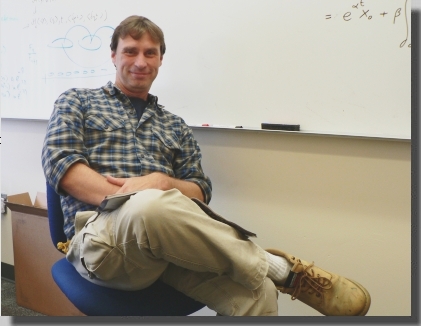|
My
research examines the electronic properties of new materials. I am
particularly interested in the ways in which structure and the quantum
mechanical corrections to the semi-classical theory of conduction
modify the behavior of electrons. My work spans three disciplines;
Physics, Materials Science, and Electrical Engineering. I grow thin
films of materials with interesting electronic properties, fabricate
devices that allow me to control aspects of the electronic conduction
in these films, and use the devices to experiment on the transport of
the electrons through the material.
Ongoing Research:
Quench Condensed
growth of Silver
When a thin film is grown onto a cryogenically cooled substrate the
atoms that arrive on the substrate surface are not free to diffuse
around on the surface. Under these circumstances we say that the
surface mobility is quenched. This means that the atoms are not able to
find their equilibrium positions in the growing Silver film. This
non-equilibrium growth process results in a thin film which is in a
meta-stable disordered phase. This phase is not only disordered but it
is an insulating phase of Silver a material which is normally thought
of as a good conductor. If we take such a quench condensed film that is
a few layers of Silver atoms thick and allow it to warm up to room
temperature slowly, it will go through a metamorphosis into an
ultra-thin conducting film of silver. This ultra-thin film is also
meta-stable but is stabilized a quantum size effect. My interest is in
understanding the details of the kinetic pathway that leads to these
ultra-thin Silver films.
Percolating Silver
and Weak Localization.
If you grow a Silver thin film on a non-wetting substrate at room
temperature the film will grow via the nucleation of isolated grains.
As the grains expand, via the diffusion of the atoms arriving on the
substrate surface, the eventually grow into one another. The coalescing
grains form larger and larger clusters until there is a single cluster
that spans the entire substrate. The point at which a single cluster
spans the substrate is known as the percolation threshold. This so
called infinite cluster has a quasi-self similar fractal geometry over
a range of length scales from the grain size up to the dimension of the
substrate. The electrons that move on this cluster are confined to the
fractal geometry. Classically their motion is diffusive, but because of
the resulting geometric constraints that diffusion becomes anomalous,
with a diffusion constant that now depends on length scale. My interest
is in how the constraints of the fractal cluster modify the Quantum
corrections to conduction known as weak localization. Weak localization
is a manifestation of the self interference of an electron. Thinking of
the electron as a wave, the scattering of that wave off of the
impurities leads to an enhancement of the probability that the electron
stays where it is rather than propagating away. This is called coherent
backscatter. Since the electron is more likely to stay in one place
than we would predict classically this increases the resistance of the
Silver film. The Quantum coherence necessary for the interference
breaks down as the temperature of the sample increases; so, the sample
has an extra, increasing resistance as the temperature goes down. My
interests are in the details of how this excess resistance changes on
the fractal cluster where the ways in which it can self interfere are
limited by the geometry.
Noise in an
Electron Glass.
Amorphous Indium Oxide is one of the few materials that are known to
undergo the Superconductor to Insulator transition. As the number of
electrons in the sample increases the material becomes a
superconductor. At low carrier densities it is an insulator. On the
insulating side of the Superconductor to Insulator transition Indium
Oxide manifests what is know as electron glass behavior. One of the
consequences of this glassiness is that if electrons in the glassy
phase are pushed out of equilibrium they decay back towards their
equilibrium configuration via an extremely constrained set of
transitions. This leads to a non-ergodic relaxation. The constraints on
the relaxation processes come about as a consequence of the
correlations that result from the strong coulomb interactions between
the electrons in the material. They cannot find their equilibrium
positions because to do so would require them to move past other
electrons which repel them. These same charge correlations lead to an
enhancement of the conductance noise is this materials: the resistance
changes a lot as a function of time. I am developing protocols for
performing conductance noise spectroscopy in Amorphous Indium Oxide
Field Effect Transistors that have been pushed away from their
equilibrium and are relaxing back as a way to understand the dynamics
of the relaxation in the glassy phase.
|
Magnetocapacitance:
probe of spin-dependent potentials
K.T McCarthy, A.F. Hebard and S.B. Arnason
Phys. Rev. Lett. 90,117201
(2003)
Growth of the
dilute magnetic semiconductor GaMnN by molecular-beam epitaxy
M.E. Overberg, G.T. Thaler, C.R. Abernathy, N.A.
Theodoropoulou, K.T.
McCarthy, S.B. Arnason et. al.
J. Electronic Materials 32,
298
(2003)
Magnetic properties
of P-type GaMnP grown by molecular-beam epitaxy
M.E. Overberg, B.P. Gila, C.R. Abernathy, S.J.
Pearton, N.A.
Theodoropoulou, K.T. McCarthy, S.B. Arnason, A.F. Hebard, Appl. Physics
Lett. 79,
3128
(2001)
Carbon
nanotube-modified cantilevers for improved spatial resolution in
electrostatic force microscopy
S.B. Arnason, A.G. Rinzler, Q. Hudspeth and A.F.
Hebard
Appl. Physics
Lett. 75,
2842
(1999)
Bad metals made
with good-metal components
S.B. Arnason, S.P. Herschfield and A.F. Hebard
Phys. Rev. Lett. 81,
3936
(1998) |


